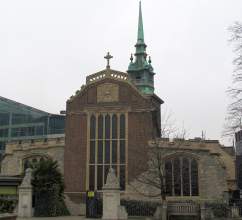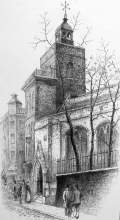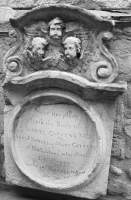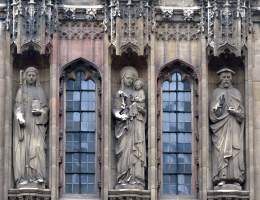 All Hallows Barking.
All Hallows Barking.
An ancient City church, the fabric and monuments including much which is pre-Fire of London, despite suffering in World War 2.
The Roman origins of the site are shown by a fragment of terrarae mosaic pavement, monuments and minor archaeological finds, see below, and remains of a Saxon church have also been found there. The church was founded by the nuns of Barking Abbey, Essex, hence All Hallows Barking . Barking Abbey was itself founded by Erkenwald, King of the East Angles, in 675, and later Bishop of London. A chapel of the late 12th Century, built in the reign of King Richard I, supposedly had the heart of this great king buried there beneath the high altar, and Edward I presented a statue of the Virgin at the end of the 13th Century. The church became dilapidated and was rebuilt, and when a ship s chandlers house against the wall storing gunpowder barrels exploded in 1649, was much damaged, after which it was repaired and the brick steeple added in 1659. At this time a sculpted wooden angel was put over the exterior clock of the church, sounding a trumpet this was later destroyed on suspicion of popery. The church passed unscathed through the Great Fire - indeed it was from the tower of All Hallows Barking that the diarist Samuel Pepys saw and described the Fire - but had several restorations in the 19th century, the last of these being in 1883 when the North Porch was added by the important Victorian architect J. L. Pearson. World War II bombing severely damaged the church, but walls, tower, the crypt of course, some of the monuments and a remarkable collection of brasses survived, the latter not covered on these pages. Rebuilding by Seely and Paget took place in 1949-58.
What we see then, is rather mixed on the outside, a picturesque combination of very old and new brick and stone, the 1883 Porch, and the top of the old tower bearing a different pinnacle than before WW2 timber covered in copper. The interior is fairly large, some 108 ft long, lofty and atmospheric, again with a mix of ancient and modern fabric, furnishings and sculpture. The north wall and Lady Chapel are particularly medieval, and include a niche with a grill containing a small wooden statue. The crypt underground is the most ancient part of the church though, and it is here that we start our quest for the sculpture and monuments that this website is concerned with.
 View showing the former tower.
View showing the former tower.
The crypt or undercroft of All Hallows Barking is arranged as a small museum. The Roman origins of the site are shown by a fragment of tesserae pavement, casts of three Roman tombstones now in the British Museum, pots, and a worn stone sculpted bust. Saxon remains include a cross and a fine square pillar, again from a cross, with much battered but characteristic carving in geometric patterns and with the remains of a half figure on the front, showing two arms with long hands, and two beasts, perhaps dogs, standing below. On the side, remains of two further figures. Saxon ecclesiastical remains of any sort in central London are vanishingly rare hence these bear examination.
From medieval times is an important panel carved from Alabaster, an English craft once much exported across Europe, which according to the label depicts St Hubert, patron Saint of Huntsmen, a unique subject for one of these panels. In a characteristically crowded scene, we see a crowned figure on his horse, holding a falcon, with five other horsed figures shown (or at least their heads and mostly bodies, and too few horses legs in Byzantine fashion), while at the base three dogs attack a small stag. Also fragments from figures or architectural sculpture a female head as a corbel, a weeping cherub holding a skull, and a winged cherubic head from some memorial, also a very small cartouche on a festoon with small sculpted flowers including a rose, nicely worked.
There are a few monumental plaques down here:
And that is it for the crypt. A separate descent gives entrance to two small chapels, with a couple of slight modern statues and two plaques of Della Robbia work. The crypt and these two little chapels, though small, add much charm to the church and enhance the medieval spirit.
There is a nave and chancel, and low aisles to north and south. The furnishings were mostly bombed, but a wooden font cover, almost certainly by Grinling Gibbons, with three angels gathering flowers and fruit, considered one of Gibbons' best, had been taken to safety beforehand and survived. Under this is a new font of Gibralter limestone. There is a Wren-era pulpit, much carved, which was brought from the extinct St Swithun s London Stone. A rather splendid four-panelled group of paintings, the Tate panel , survived from an altarpiece of the late 15th century, and according to a label, come from Bruges in Belgium. There would have been a central panel, believed to show the adoration of the magi. Sir Robert Tate, the donor, had a chapel built for his tomb, as part of the Royal Lady Chapel which was later destroyed. An anonymous altar tomb with a canopy, made of Purbeck marble, which survived in the church until WW2, may plausibly have been his tomb. Another alterpiece, well carved with wreaths and scrolls and with paintings of Moses and Aaron, the gift of John Richardson in 1685, has not survived, and there is a modern painting of the Last Supper by Brian Thomas. The modern stained glass has descriptive pictures, including an evocative one with a ship, commemorating the Houlder Line Royston Grange, lost with all hands in the River Plate, 1972. And another one showing a little knight in armour, Sir Robert Knollys, d.1407, friend of the Black Prince, and who built a bridge across Seething Lane. Before turning to the stone monuments, we should note three small wooden figures of mediaeval times:
As noted before, this page does not cover the brasses, which fall outside the scope of this website.
 Monument to Gittens, in the churchyard.
Monument to Gittens, in the churchyard.
The monuments are several, and we may note the following:
Gunnis records three 18th C monuments by Peter Scheemakers, to Charles Wathen, d.1721, Anne Colleton, d.1741, and Francis Sherwood, d.1744, all destroyed or damaged in WW2. The Colleton monument was a grievous loss - it was a large thing, including sarcophagus on a plinth, a pyramid or obelisk above with a portrait bust of the deceased, in Roman costume, and two full sized cherubs standing next to the sarcophagus and leaning their elbows upon it. Beneath, two high relief pots on the base. The other two monuments were panels, that to Wathen including two winged cherub heads.
We should also mention one other monument among the 20 or so lost in the war, to James Hickson, d.1689. This was an ornate panel monument, with Corinthian pillars, scrolls, an open pediment on top with a shield, two reclining cherubs holding skulls on either side, and at the base, a further winged cherubic head. Hickson was a benefactor of the poor, and among his various charitable works, the inscription recorded his building of an almsouse for six poor people in the parish of South Mimms, Middlesex, and that he founded a school in the locality of the church, to educate 20 poor children.
There are a couple of modern panels and three interesting modern sculptures to note:
Outside, in what remains of the churchyard are two monuments: a tomb monument with inscription on a panel and minor carving, to Joseph Steele of Cumberland, d.1835 and his brother Henry Steele; and a modest stone panel to Samuel Gittens, d.1777, son of Samuel and Mary Gittens of Barbados a roundel on a square panel, with above, three rather worn cherubic heads under a canopy with a swirl on each side.
We may also mention exterior modern sculptural adornments: On the east front, high up, is a modern stone panel with male angels around an urn. And there are two short limestone pillars, with pyramidal groups of infant waterchildren or young mermaids, female and male, with little dolphins. And on Pearson's north porch and hence dating from about 1883, are three fine figures in stone, shown below. They are a central Virgin and child, St Ethelburga to the left, and some male saint to the right. The sculptor was Nathaniel Hitch, who specialised in such work.
 Nathaniel Hitch's figures for the North porch.
Nathaniel Hitch's figures for the North porch.
Go west to St Mary at Hill // or to St Dunstan's in the East // North to St Olave Hart Street
City Churches // London sculpture // Sculptors // Introduction to church monuments
Angel statues // Cherub sculpture
Visits to this page from 13 Mar 2014: 10,151